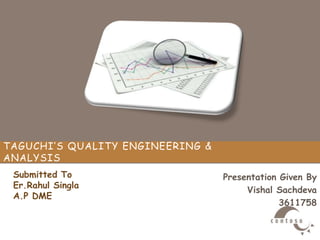
Taguchi’s quality engineering & analysis
- 1. TAGUCHI’S QUALITY ENGINEERING & ANALYSIS Presentation Given By Vishal Sachdeva 3611758 Submitted To Er.Rahul Singla A.P DME
- 2. BIBLIOGRAPHY
- 3. TAGUCHI’SLOSSFUNCTION What were Taguchi’s views about quality?? •Taguchi defines Quality Level of a product as the Total Loss incurred by society due to failure of a product to perform as desired when it deviates from the delivered target performance levels. •This includes costs associated with poor performance, operating costs (which changes as a product ages) and any added expenses due to harmful side effects of the product in use
- 4. EXPLORINGTHETAGUCHIMETHOD The Loss Function Considering the Loss Function, it is quantifiable Larger is Better: Smaller is Better: Nominal is Best: 2 1( )L y k y 2 ( )L y ky 2 ( ) : m is the target of the process specification L y k y m where
- 5. 0 2 0 0 0 is cost of repair or replace a product and must include loss due to unavailability during repair is the functional limit on y of a product where it would fail to perform its function half the A k A time THECOSTOFLOSS Considering The Cost Of Loss (K) k in the L(y) equation is found from:
- 6. LOSSFUNCTIONEXAMPLE Nominal Is Best We can define a processes average loss as: s is process (product) Standard Deviation y(with bar) is process (product) mean 2 2 L k s y m
- 7. EXAMPLECONT. •A0 is $2 (a very low number of this type!) found by estimating that the loss is 10% of the $20 product cost when a part is exactly 8.55 or 8.45 units •Process specification is: 8.5+.05 units •Historically: ybar = 8.492 and s = 0.016
- 8. EXAMPLECONT. •Average Loss: •If we make 250,000 units a year •Annual Loss is $64,000 2 2 2 2 0.016 8.492 8.500 .05 800 .00032 $0.256 L L
- 9. FIXINGIT Shift the Mean to nominal Reduce variation (s = 0.01) Fix Both! 22 800 .016 0 $0.2048 Annual Loss is $51200 about 20% reduction L 22 800 .010 .008 $0.1312 Annual Loss is $32800 about 50% reduction L 22 800 .010 0 $0.08 Annual Loss is $20000 about 66% reduction L
- 10. TAGUCHIMETHODS Benefits To Companies •Help companies to perform the Quality Fix! Quality problems are due to Noises in the product or process system Noise is any undesirable effect that increases variability •Conduct extensive Problem Analyses •Employ Inter-disciplinary Teams •Perform Designed Experimental Analyses •Evaluate Experiments using ANOVA and Signal-to noise techniques.
- 11. TAGUCHIAPPROACH Defining The Taguchi Approach •The Point Then Is To Produce Processes Or Products The Are ROBUST AGAINST NOISES • Don’t spend the money to eliminate all noise, build designs (product and process) that can perform as desired – low variability – in the presence of noise! Here: ROBUSTNESS = HIGH QUALITY
- 12. TAGUCHIAPPROACH Defining The Taguchi Approach Noise Factors Cause Functional Variation They Fall Into Three “Classes” 1. Outer Noise – Environmental Conditions 2. Inner Noise – Lifetime Deterioration 3. Between Product Noise – Piece To Piece Variation
- 14. TAGUCHIAPPROACH Defining the Taguchi Approach •TO RELIABLY MEET OUR DESIGN GOALS MEANS: DESIGNING QUALITY IN! •We find that Taguchi considered THREE LEVELS OF DESIGN: level 1: SYSTEM DESIGN level 2: PARAMETER DESIGN level 3: TOLERANCE DESIGN
- 16. TAGUCHIAPPROACH SYSTEM DESIGN •All About Innovation – New Ideas, Techniques, Philosophies •Application Of Science And Engineering Knowledge •Includes Selection Of: Materials Processes Tentative Parameter Values
- 18. TAGUCHIAPPROACH Parameter Design •Tests For Levels Of Parameter Values •Selects "Best Levels" For Operating Parameters to be Least Sensitive to Noises •Develops Processes Or Products That Are Robust •A Key Step To Increasing Quality Without Increased Cost
- 20. TAGUCHIAPPROACH Tolerance Design •A "Last Resort" Improvement Step •Identifies Parameters Having the greatest Influence On Output Variation •Tightens Tolerances On These Parameters •Typically Means Increases In Cost
- 21. OVERALLCONCLUSION Taguchi methods summary •Taguchi methods (TM) are product or process improvement techniques that use DOE methods for improvements •A set of cookbook designs are available – and they can be modified to build a rich set of studies (beyond what we have seen in MP labs!) •TM requires a commitment to complete studies and the discipline to continue in the face of setbacks (as do all quality improvement methods!)
- 22. Thank You